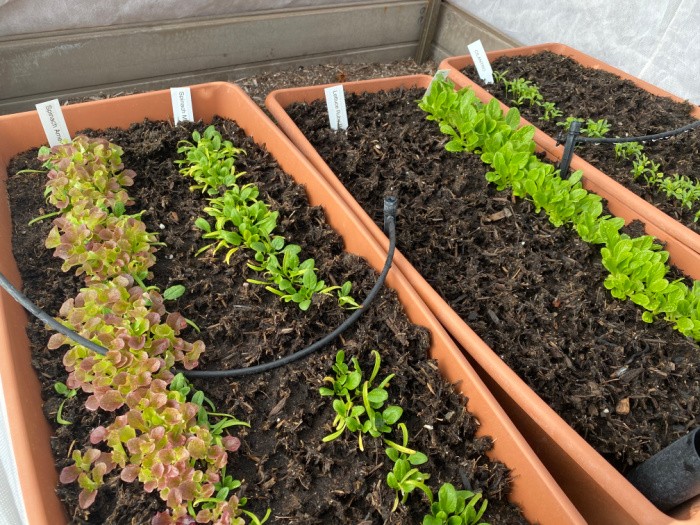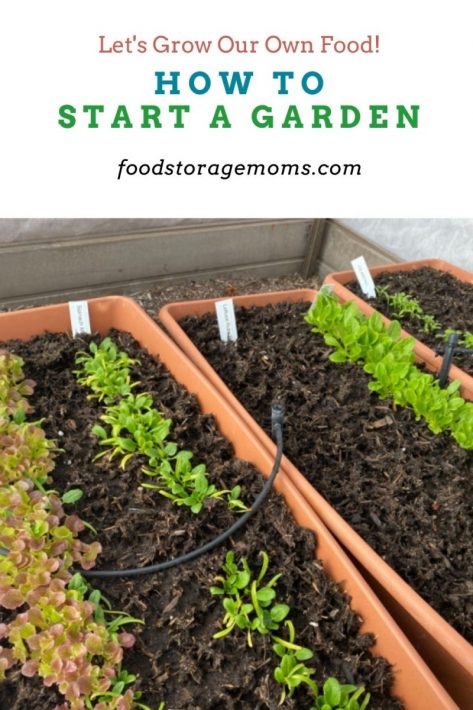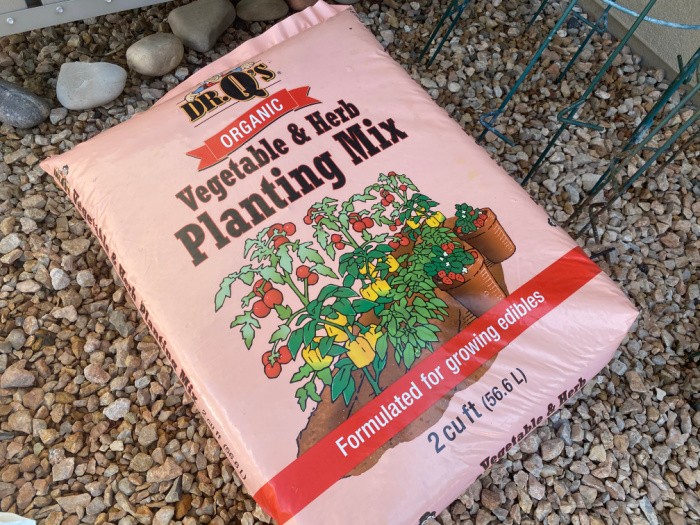
Have you been thinking about starting your own garden for a while now but you feel a little intimidated and fear that you’ll end up in over your head? The truth is, if you keep it simple and plan wisely, gardening is actually easier than you may think. If you’re looking to get your hands a bit dirty so that you can be rewarded with beautiful blooms or tasty and delicious veggies, I’d be more than happy to help you.
There’s been a lot of talks lately about water quality and shortages of water, particularly in the western United States. How you plan out your garden must contain an element of how you’re going to efficiently water the plants. There are a number of approaches, and depending on the plants, the soil structure, the planting zone you live in, and other factors, you need to pick the best approach for you.
In today’s post, I’m going to update what I presented a few years ago. I hope you find it helpful.
In case you missed this post, Marigolds: Planting Them In Vegetable Gardens or How To Plant Vegetables On Your Deck
This is where I buy my garden seeds: SeedsNow
I highly recommend these for seedlings: CowPots and Organic Seedling Soil, this way you plant your seeds and place the CowPots in your garden when the temperatures are right.
How to Start a Garden

Find the Best Spot in Your Yard
Before you decide to pick any old spot in your backyard for your garden, I’d encourage you to observe your yard on a sunny day. Find out which location receives the most direct sunlight and how many hours of full sun you can plan on. Since some plants require lots of sunshine, you also need to consider where there’s partial or full shade.
Most plants and vegetables need about 6 to 8 hours of direct sunlight each day. Don’t be discouraged if your backyard is mostly shaded all throughout the day with limited hours of sun. Many of us have to contend with a tall home, lots of trees or large shrubs, walls, fences, etc. There are still plants that will thrive with little sunlight (outdoor ferns and hostas).
Another thing that you need to think about is choosing a spot that is mostly flat. While you can plant your garden on a slope, it’s more challenging and will cost you more with watering and fertilizer throughout the season due to runoff. This step is super important when learning how to start a garden.
Consider What You Will Plant
What are you planning on growing in your garden? Are you simply looking to add beauty and more color to your yard, or are you thinking about delicious vegetables and herbs that you’ll enjoy? My advice to you is to keep it simple until you have a growing season or two under your belt.
Cucumbers, tomatoes, peppers, and lettuce are all vegetables that are fairly easy to grow for the first-time gardener. If you’re thinking about planting annual flowers that bloom for most of the summer, then marigolds, zinnias, sunflowers, cosmos, and impatiens are all great choices.
But if you’re wanting perennial flowers that come back year after year, lamb’s ear, pansies, coneflowers, daylilies, and Black-eyed Susans are good perennial options.
The space you have is also a consideration. If there’s limited space, then you’ll want to stay away from some of the plants with vines that spread out like watermelon and cantaloupe.
Remove any Sod
When you’ve decided where you will place your garden, if it includes an area where you’ve had lawn/grass, now’s the time to remove any sod by getting under the grass using a spade. Whatever sod you decide to remove, go ahead and throw it on your compost pile.
The best time to get your garden’s soil ready is actually in the fall. Lay 5 sheets of newspaper over your planting bed area and then spread a 3-inch layer of organic material on top. This will form a layer of compost (topsoil and potting soil) over the newspaper to help condition the soil. Allow it to sit all winter long and decay in the process. By springtime, you’ll have a garden bed that has rich soil and no stray grass or weeds present.
Enrich Your Soil
A good way to improve your garden’s soil no matter its current condition is to add a few inches of organic matter to it such as grass clippings, decaying leaves, and manure. When your garden’s soil is fertile, your flowers and vegetables will grow better, so that should be more than enough reason to make sure you take this step. This is my favorite soil, Dr. Q’s Organic Vegetable & Herb Planting Mix (I buy it at my local garden center).

Garden Soil Amendments:
Garden soil is just like us in many ways. We will grow stronger if we eat the right foods. Your garden needs fertilizer or soil amendments such as these:
Unco Industries Wiggle Worm Soil Builder Earthworm Castings Organic Fertilizer, 15-Pound
If you’re just starting out with your garden journey, you should strongly consider a soil test. It can provide you with some idea of the soil’s nutrient content and also the PH of the soil. Soil has a certain level of acid and/or alkaline. If the PH is too high (alkaline) or too low (acidic) then the plants can’t absorb whatever nutrients are available in that soil.
Each plant species is different when it comes to the desired PH, so you’ll need to acquaint yourself with these factors and then plant and maintain the soil accordingly. Using natural fertilizers or suggested chemicals to strengthen the plants as they grow and mature is critical.
Till the Soil
Tilling or turning over the soil is a great way to stir up the nutrients in the soil and allows your plants’ roots to penetrate through the soil easier. You can also do this step by digging and stirring the soil if you don’t have a tiller. Just be careful not to do this when the soil is too wet or excessively dry because this can change the structure of the soil and you won’t get the results you want. You don’t want the soil to be all clumped up and hard to work with as you add the plants.
Time to Plant
Make sure that you read the seed packages so that you don’t plant too early because most plants don’t handle frost very well. You may want to think about planting your seeds indoors so that you can get a head start and then transplant them once the weather has entered the needed warm season. Be sure to check out my links below that tell you when you should be planting various plants in each geographic zone during the year.
Some plants do well in cooler weather and others don’t. You can determine the hardiness zone for each plant and then move forward at the appropriate time to dodge frost dates and achieve the best gardening zone conditions for the plants you want. Often the seed packages or nursery instructions will reference a “last frost date” as a guideline to follow.
The seed package will also tell you about how far you need to space your seeds, the depth that you need to dig, and how tall your plants will end up. Be sure that you keep the soil moist, but not too wet, or the seeds may begin to rot even before they grow.
Water at the Right Time
Watering your garden in the early morning is the best time to do so because it won’t evaporate as quickly as it does during the hotter part of the day.
When you’re first starting out with your garden, your seedlings need to be watered on a daily basis and then back off a bit as your plants begin to get bigger. If you plan to transplant them from indoors, those transplants will need frequent watering until they have taken root.
Once your plants have started to take off, how often you water them will depend on the amount of rainfall, humidity, and the type of soil that you have. Sandy soil dries out fairly quickly and lets the water soak through. Clay soil holds on to moisture longer so that you won’t have to water nearly as often. Clay soil may not let the water sink in as well if allowed to totally dry out.
Try to balance the watering frequency. You may need to gently turn the soil over around the base of the plant from time to time so the water can properly penetrate and get to the roots.
Add Natural Moisture to Your Garden
Adding mulch to your garden will help keep your soil moist so that you don’t have to water it nearly as often. It will also keep direct sunlight from reaching your garden’s soil or damaging those close to the surface roots. Mulch can help protect the plants so you won’t be dealing with so many germinating weeds that sprout up everywhere. I love organic earthworm castings in my garden as well.
If you’re considering a vegetable garden, I’d suggest that you use a mulch that decomposes after several months, but if you’re planning on simply growing perennials, go ahead and get the wood chips that will last you for a season or two.
Some gardeners get pretty creative when adding things to the soil that help maintain moisture. One item you can consider is cut-up cardboard. It doesn’t add much nutritional value but can help keep the soil moist longer.
Maintain Your Garden
Now that your flower plants or vegetables have been planted beneath the soil and have begun to grow, the important work still isn’t over. You’ll need to keep up with your garden by pulling weeds regularly and removing any vegetation that is dying or appears diseased.
Keep the pests away by spraying your garden with a non-toxic insecticidal soap. Many gardeners are now trying to shy away from the old standard pesticides and call their gardens organic. That is a worthy choice that will require more research on your part to determine the common pests for the plants you have and how to “organically” treat them.
When you have taller plants in your garden, such as tomatoes, you’ll want to support them with stakes or a trellis. That makes it possible for them to continue to grow properly without the plant’s branches breaking from the weight of the growing vegetables.
If you enriched your soil before you began planting, you may not need to do any additional fertilizing. But if you’re growing vegetables like corn or tomatoes, you’ll want to fertilize about every three to four weeks. Now it’s time to enjoy the smells and the tastes of your garden. Be sure to harvest your vegetables when they are ready. In case you missed this post, Container Gardens: Everything You Need To Know
Garden Gloves and Tools
These are my favorite garden gloves: DIGZ Garden Gloves They come in different sizes, and that’s what I love the most. These are the best rose bush gloves: DIGZ Rose Bush Garden Gloves I have to get a large size for my hands. These are awesome! If your hands aren’t used to shovels, rakes, and other garden tools, you’ll want to invest in some comfortable quality gloves, you’ll be glad you did!
Speaking of shovels, rakes, and other tools, you’ll learn that you can’t do everything needed with your hands alone. As with so many other things, I’ve always suggested to my readers to buy right the first time and get good quality tools that will serve them well for a long time.
Please Check Out What To Plant Each Month:
- What To Plant In January
- What To Plant In February
- What To Plant In March
- What To Plant In April
- What To Plant In May
- What To Plant In June
- What To Plant In July
- What To Plant In August
- What To Plant In September
- What To Plant In October
How to Start a Garden
Final Word
Whether you’re starting a garden to add beauty to your backyard, or all sorts of delicious vegetables on your table, you’ll be richly rewarded if you follow these steps. If you consider yourself an expert gardener, what other important information would you tell beginners who are looking to turn their thumbs green? What tips would you give to someone regarding how to start a garden that I can share with my loyal readers? May God Bless this world, Linda
The post How to Start a Garden appeared first on Food Storage Moms.
